Baseball History – Hay Lakes
Posted July 9, 2019

Like many small towns in Alberta, Hay Lakes has a lengthy history with baseball, dating back to 1920. While the Powerline Baseball League has never had a foothold in Hay Lakes, many players have come from the area and the teams from the Breezy League and surrounding school districts, often participated in the same local tournaments as Powerline Baseball League teams.
The Armena Royals are the last ties to the baseball that was played in the Hay Lakes and New Sarepta area. Armena was an original member of the Breezy League in 1933 when the Armena Owls were joined by teams in Hay Lakes, Sulitjelma and Dinant West. The Owls would go on to win the Breezy League in 1935, 1936 and 1937. The Breezy League would cease operations at some point in the 1950s. For more information on the Armena baseball history you can check out the Armena Royals History page.
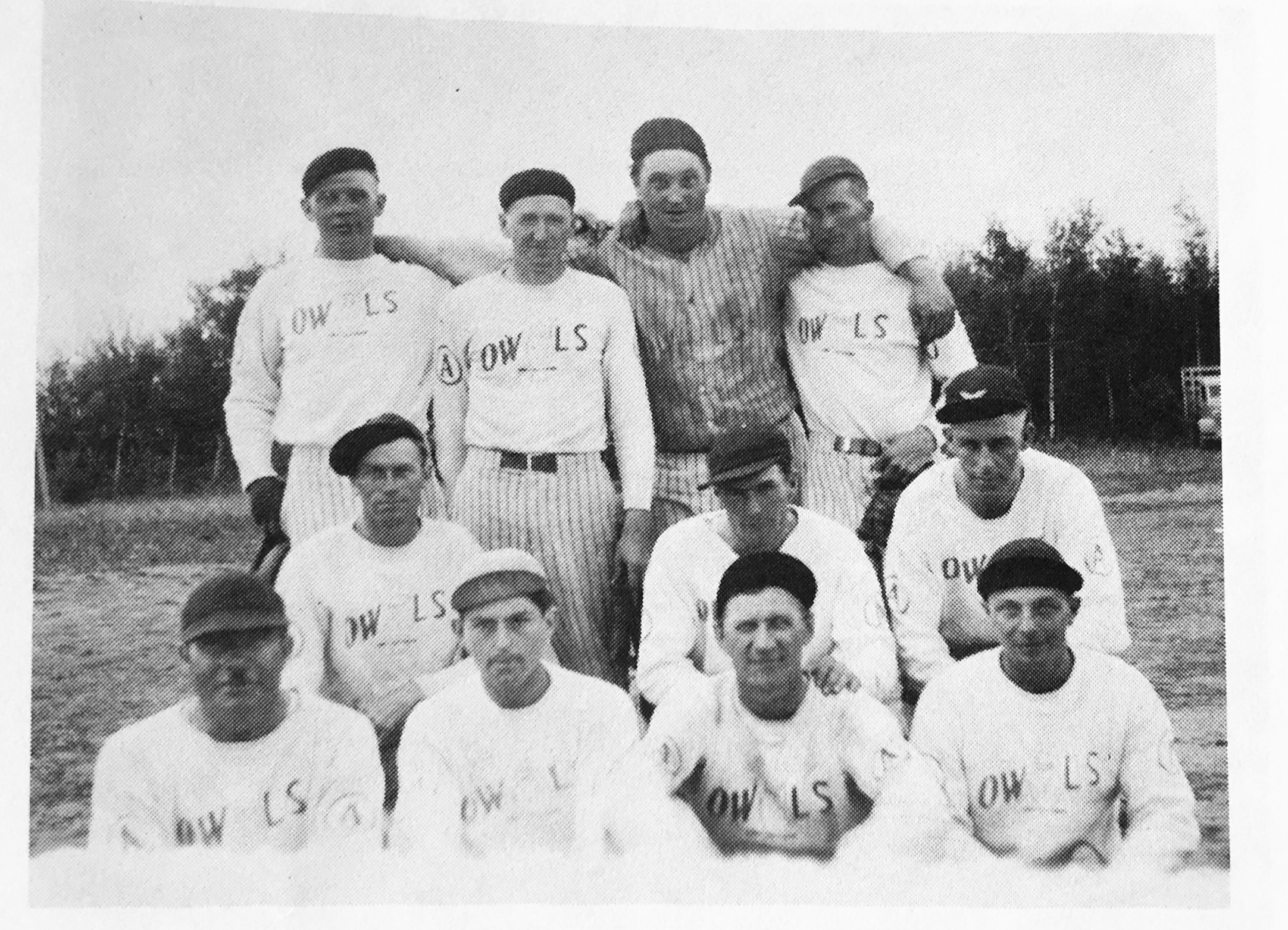
Armena Owls Cupholders, 1935. Back Row L to R: Orvil Pedersen, Ed Jasman, Tiny Mittlestadt, Andy Erickson. Centre Row L to R: Herman Erickson, Bob Wylie, Frank Olson. Front Row L to R: Evald Sodestrom, Johnny Kaiser, Art Jasman, Walter Olson.
Once again, local baseball history was found in the history books put together by community members. Below are the baseball content found in the Hay Lakes history book put together in 1982, Each Step Left Its Mark: A History of Hay Lakes and Surrounding Area.
The Sulitjelma Baseball Team
submitted by Henry Pearson, From Each Step Left Its Mark: A History of Hay Lakes and Surrounding Area (1982)
The Sulitjelma baseball team originally was organized around 1920. It was made up of local farm boys who with time became top-notch players, resulting in some real good teams. The nucleus of this Sulitjelma team in the early twenties were the Miller boys led by Fred Miller who was our coach and manager. Fred had played semi-professional ball in the Twilight League in Chicago previously, and since arriving in the district shortly after the turn of the century he was in great demand throughout central Alberta as a catch in baseball tournaments. At these special games some of the sponsors would wager large sums of money.
In later years, Fred moved to first base. Ed Miller held down second base and Joe Miller third base. Ingwald Feragen was the pitcher, John Warcup Morrison was catcher, Hank Pearson (myself) in centre field and as relief pitcher. The short-stop was filled by Fred Hustad who was a grain buyer from Hay Lakes. Left and right field were alternated by local farm boys.
The Sulitjelma ball team was also the main-stay of the Hay Lakes team in the early twenties and thrirties, when they would combine forces on sports days and tournaments. New Sarepta was perhaps out toughest opposition and this would lead to a lot of rivalry between the two teams. The teams would import a special battery made up of a pitcher and catcher; New Sarepta came up with the Mix brothers from Fredricksheim. Big Mix was a smoke ball pitcher; his control was not the best, so about the only way to get on base was by way of a “hit” batter. I remember one game when our third-base man got hit three times. This led to a dispute which nearly ended in a free-for-all.
Sultijelma played in a league with Armena, Dinant and in many exhibition games with Kingman, Round Hill, Camrose, Gwynn and also Canard. Lefty Gemroy was one of the earliest pitchers for Hay Lakes, Martin Badner was also one of the great pitchers that played for Hay Lakes in the early thirties. Easy Hay Lakes came up with a well-balanced ball team in the forties, coached by Johnny Erickson.
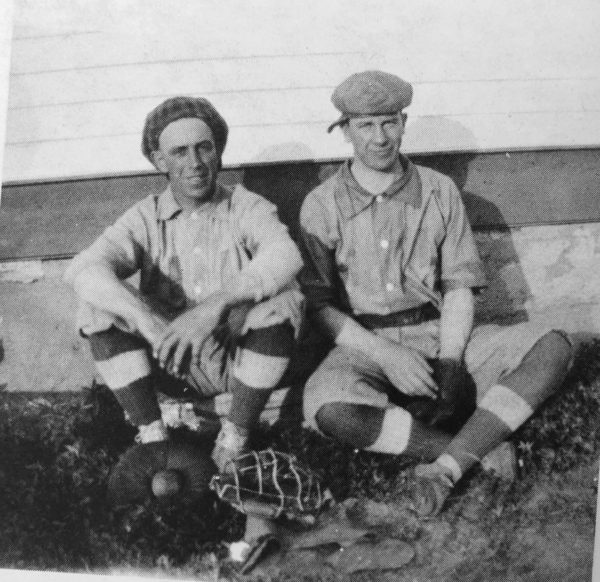
Sulitjelma Ball Team (date unknown). Fred Miller and John Morrison.
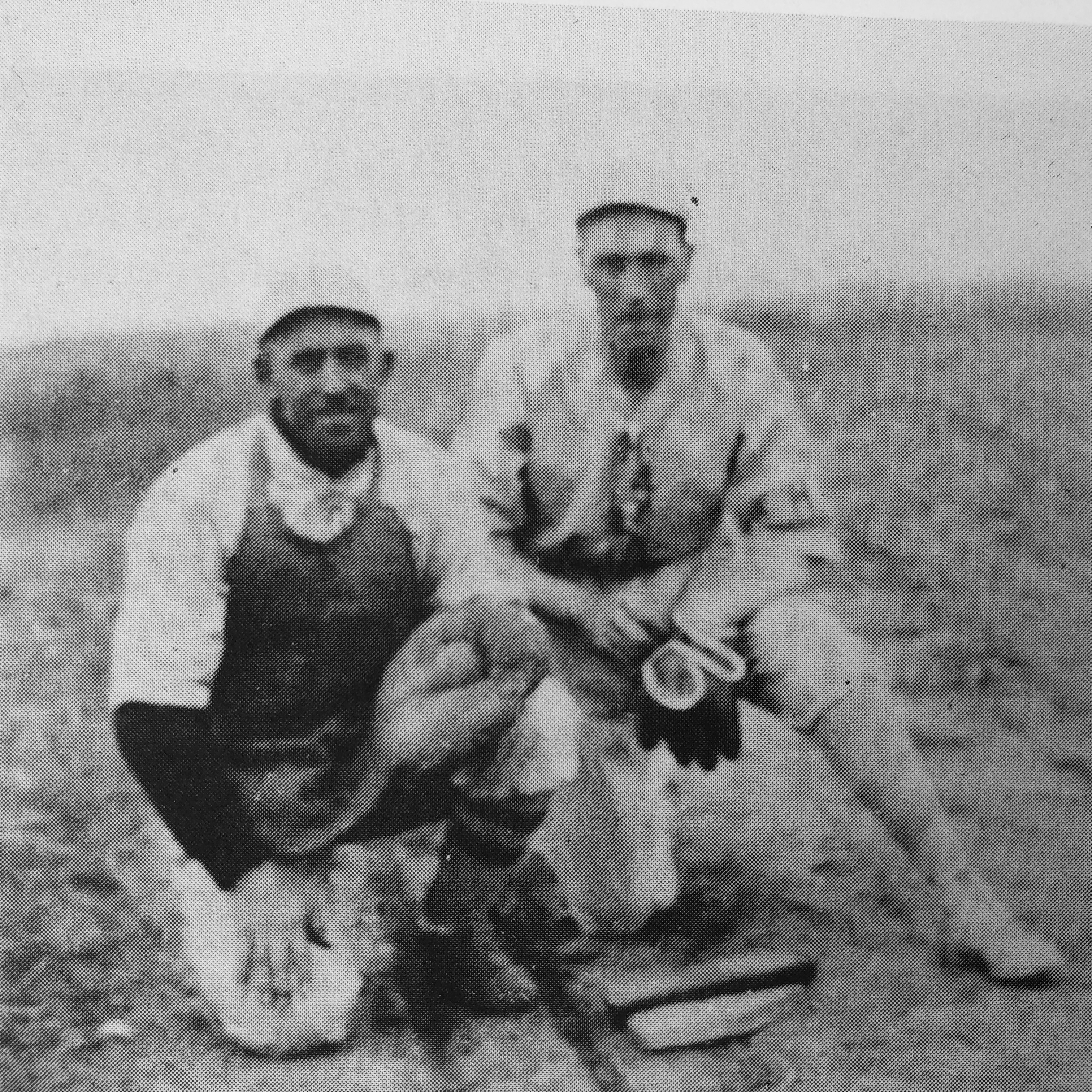
Sulitjelma Ball Team (date unknown). Fred and Joe Miller.
Baseball and Fastball
Around 1935 the “Breezy League” was formed with teams from Dinant, Armena, Sultijelma and Hay Lakes. This later evolved into a league comprised of Duhamel, Armena, East Hay Lakes and Hay Lakes where great rivalry prevailed, and the trophy became the ultimate goal of each team. The names predominating at this time were Millers, Nordins, Johnsons, Persons, Ericksons, Jornlins, Throndsons, Jasman, Mittlestat, Rachues, Werners, Sochs, Ropers, Soderstroms, Moores, to mention a few.
As the original team members retired or moved away, the league folded. A good junior team then took the limelight with names like Eliason, Forsen, Fuernkranz, Wahl, Rost, Sware and many more in the line-up. The carried the local banner until Fastball became the dominant game and Baseball at the Senior level was no more.
Throughout the years of 1928-53, Hay Lakes boasted the finest infield or diamond, for many miles around. Fast, hard and true, it was a fielder’s delight – but it did leave many “burns” on the bodies of those choosing to slide on a “squeeze” or steal. Community Sports days always highlighted a baseball tournament during these years, much the same as fastball now holds the spotlight.
Some of the young boys from Hay Lakes continued to play baseball in the County of Camrose League until the early seventies. Teams from Hay Lakes won County Baseball Championships in 1970 and 1973 and were the last teams to play baseball here.
Fastball became popular here during the early 1960s when most neighbouring centres began fielding teams. The Hay Lakes Senior Men’s Faseball Team have represented Hay Lakes in the South Edmonton Rural Fastball League for the past few years and have been very competitive.
Each year several young teams fro Hay Lakes (boys and girls) play fastball in the County of Camrose program. Many are successful in winning championships and continue to do so, the latest being the 1981 boys bantam team, carrying on the tradition of the fine athletes that have emerged from this area.
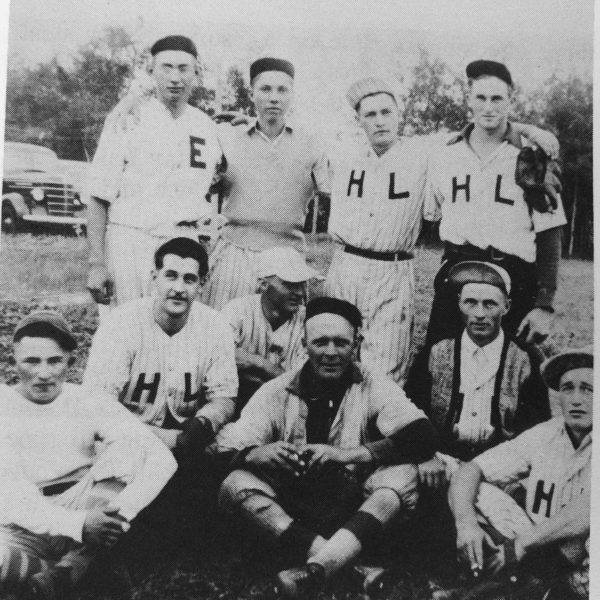
Hay Lakes Baseball Team 1938-1939.
Back Row L to R: Nick Masikewich, Ernest Lerke, Paul Schmidt, George Roper.
Seated L to R: Clifford Sikstrom, Walt Schmidt, Carl Nordin, Philip Thompson, Rudolph Nordin, Eddie Kreamer.
Baseball
Baseball proved to be popular pastime for residents of Hay Lakes as early as June, 1916. Then it was reported in the local news in the Camrose Canadian that the baseball team was getting into shape for the coming season and again in 1919 when the team organized and held a benefit dance after a game with Bittern Lake. Then on February 12, 1921 a dance was held in the Cox Cafe whose proprietor also donated the supper. A sum of $66.25 was raised for the purpose of obtaining new uniforms. An additional fund was raised by staging a local talent show which netted the Club a sum of $139.50. The community did seem to have an abundance of talent for playing baseball during that summer, since they were able to put three teams into the field. These teams were namely, the Hay Lakes Senior Club, the Junior Oilcans and a club from West Hay Lakes which called themselves the Sauerkrauts.
The Senior team got off to a shaky start when they suffered two losses from Britten Lake. However, the team gained momentum as new talent was recruited to replace some of the deadwood on the team. By late summer of 1921 there were able to pool some of their best talent and challenge an all-star team from Edmonton. Their final triumph was to win the Northern Alberta Intermediate Championship that summer. Much of their success was attributed to their ace pitcher, Mr. Gordon Gemray who had played semi-pro-baseball before coming to Hay Lakes on a teaching assignment. There were several other players on that roster who had semipro-experience. The best known was Fred Miller who start his baseball career in the Brooklyn Farm System before emigrating to Alberta. Fred Miller became somewhat of a legend among baseball fans from his cunning strategy in mastering the team.
There was no organized league competition prior to 1933. This form of entertainment was rather restricted to Sunday exhibition games between the local squads.
The annual Sports Days brought the teams together from many distant communities to compete. The annual Summer Fairs that were held in Camrose and Wetaskiwin were highlighted with a baseball tournament where teams from the surrounding district would compete. The Hay Lakes team won several prizes in these tournaments in the early twenties according to the weekly paper reports taken from microfilms in the Archives. However, the best baseball coverage was published during the latter part of the twenties. This paper was edited by J.W. Morrison who would provide readers with an inning by inning description of the rivalry competition that existed between the New Sarepta and the Hay Lakes squads. However, the rivalry was terminated in 1930 along with the Hay Lakes Times.
The termination of this rivalry resulted from popularity of the softball matches at New Sarepta. Meanwhile, the popularity of the baseball matches continued around the Hay Lakes area when a league competition was formed between Dinant, Armena, Hay Lakes and Sultijelma. The tradition of baseball survived for another three decades around the Hay Lakes area by much of the fan support was distracted by the number of softball teams that sprung up around the area.
The first ball diamond where this entertainment was provided for the local fans was located near the Pithouse store where a patch of natural prairie was put to good use. This property was subdivided into lots in 1956 and the Ball Park was relocated on another path of open prairie. This ball diamond was located on some homestead land that was owned by Mr Charles Chettleborough. This location is presently used for the school playground. The use of this ball diamond was of short duration however. The property was obtained by Joseph Kreamer who developed the property into farm land by 1928. A new ball park was developed by the Hay Lakes Ball Club in the summer of 1928. This athletic park was located west of the present curling rink. It served the Hay Lakes community for twenty-five years and was replaced by the present ball park in 1953.
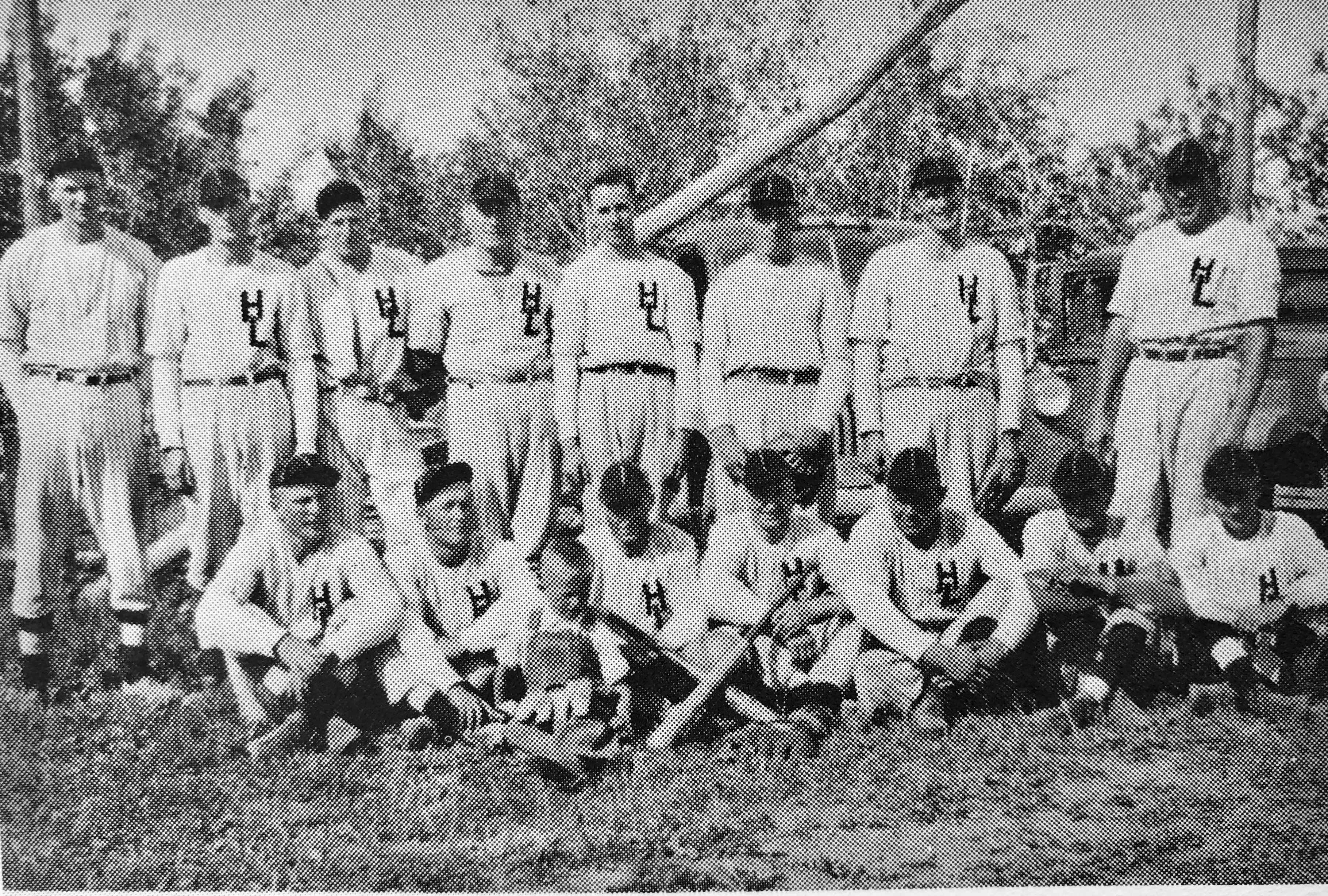
Hay Lake Baseball Team 1948.
Back Row, L to R: Art Rachue, Leo Rubis, Trevor Roper, Robert Berkholtz, Harvey Grahn, Ewald Soch, George Roper, Art Soch.
Seated L to R: Albert Werner, Eddy Kreamer, Rudy Nordin, Carl Nordin, Henry Karpowich, Alex Radowitz, Art Rost. Allen Kreamer is bat boy.
East Hay Lakes (Brandland) Baseball Team
It all began in the early 1930s when we had a very sports minded school teacher at Brandland School, named Arthur W. Eriksson, who now is living in Edmonton. Arthur worked very hard to get the young people in the community interested in sports, and he had good success.
The school pupils started playing softball using ragged balls, sticks and pieces of boards or whatever could be found for bats. They had a grand time. Brandland used to play ball against the other country schools such as Sultijelma, Pretty Hill, Throndson and Swan Hill and others. In those early years Brandland took some terrific beings but as the years progressed and the Brandland children improved in their abilities, the situation was reversed somewhat and they started to win a few games.
Mr. Eriksson was instrumental in getting the older boys interested in playing hardball and soon a team was formed called the Brandland Cougars. Some of the older boys who were still going to school used to practice hardball with the team and when they quit school they were full-fledged members of the baseball team.
After some years some of the older boys got too old to play ball so they quit and younger ones took over. In this manner a constant new crop of boys was available. For a number of years a baseball league had been in operation called the Breezy Baseball League. Teams from Hay Lakes, Sultijelma, Armena and Dinant made up the league. Brandland used to play exhibition games with these teams. Then in the mid-thirties the Dinant team disbanded and this was the opportunity for Brandland to join the Breezy Baseball League. There were some great ball games played in those days and the competition was very keen, especially between Hay Lakes and Brandland.
The League consisted of twelve or fourteen game schedule, finishing with semi-finals and finals. In 1939 Brandland qualified for the finals and beat Hay Lakes for their first championship in the Breezy Baseball League. In September 1939, war broke out and this caused the league to disband for the duration of the war.
After the war when the boys returned home, the league was reorganized with the same fierce competition between the teams. As a reorganized league Brandland changed its name to East Hay Lakes as there was a community club formed during the war called the Cheery Chums and this club sponsored the ball team for a number of years.
In those days there were no fences around the ball parks so in order to hit a home run you had to hit the fall over the fielders. The number of home runs hit proved that there were long ball hitters in those days too.
In 1949, East Hay Lakes again reached the finals against Hay Lakes and had a hard-fought five-game series. (Excerpts from the Camrose Canadian)
In the early 1950s Hay Lakes finally beat East Hay Lakes in another hectic series. The following years saw baseball die a slow death as softball, or fastball as it is called today, took over. This also proved to be the end of the Breezy Baseball League which had provided a lot of fun and entertainment for players and fans alike. In this day of highly organized sports and highly paid players its hard to envision the fun and enjoyment had by hundreds of people with a minimum of organization.







